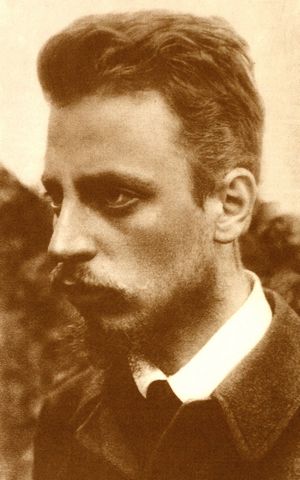

Queer Places:
Cimetière de Raron
Raron, Bezirk Raron, Valais, Switzerland
 René Karl Wilhelm Johann Josef Maria Rilke (4 December 1875 – 29
December 1926), better known as Rainer Maria Rilke, was a Bohemian-Austrian
poet and novelist. According to Ralph Freedman, author of Life of a Poet: Rainer Maria Rilke (1998), the poet had an idealistic adolescent pact with another boy at military school, sealed by a handshake and a kiss, as Rilke put it in a letter.
René Karl Wilhelm Johann Josef Maria Rilke (4 December 1875 – 29
December 1926), better known as Rainer Maria Rilke, was a Bohemian-Austrian
poet and novelist. According to Ralph Freedman, author of Life of a Poet: Rainer Maria Rilke (1998), the poet had an idealistic adolescent pact with another boy at military school, sealed by a handshake and a kiss, as Rilke put it in a letter.
He is "widely recognized as one of the most lyrically intense German-language poets".[1] He wrote both verse and highly lyrical prose.[2] Several critics have described Rilke's work as inherently "mystical".[3][4] His writings include one novel, several collections of poetry and several volumes of correspondence in which he invokes haunting images that focus on the difficulty of communion with the ineffable in an age of disbelief, solitude and profound anxiety. These deeply existential themes tend to position him as a transitional figure between the traditional and the modernist writers.
Rilke travelled extensively throughout Europe (including Russia, Spain, Germany, France and Italy) and, in his later years, settled in Switzerland — settings that were key to the genesis and inspiration for many of his poems. While Rilke is most known for his contributions to German literature, over 400 poems were originally written in French and dedicated to the canton of Valais in Switzerland. Among English-language readers, his best-known works include the poetry collections Duino Elegies (Duineser Elegien) and Sonnets to Orpheus (Die Sonette an Orpheus), the semi-autobiographical novel The Notebooks of Malte Laurids Brigge (Die Aufzeichnungen des Malte Laurids Brigge), and a collection of ten letters that was published after his death under the title Letters to a Young Poet (Briefe an einen jungen Dichter). In the later 20th century, his work found new audiences through use by New Age theologians and self-help authors[5][6][7] and frequent quotations by television programs, books and motion pictures.[8] In the[9]
Shortly before his death, Rilke's illness was diagnosed as leukemia. He suffered ulcerous sores in his mouth, pain troubled his stomach and intestines, and he struggled with increasingly low spirits.[37] Open-eyed, he died in the arms of his doctor on December 29, 1926, in the Valmont Sanatorium in Switzerland. He was buried on January 2, 1927, in the Raron cemetery to the west of Visp.[37]
A myth developed surrounding his death and roses. It was said: "To honour a visitor, the Egyptian beauty Nimet Eloui Bey, Rilke gathered some roses from his garden. While doing so, he pricked his hand on a thorn. This small wound failed to heal, grew rapidly worse, soon his entire arm was swollen, and his other arm became affected as well", and so he died.[37]
Villa Discopoli, Capri
My published books: